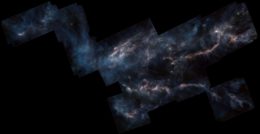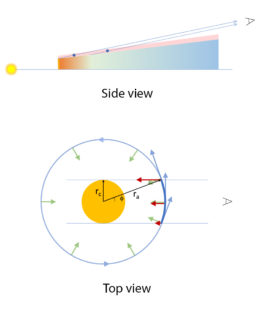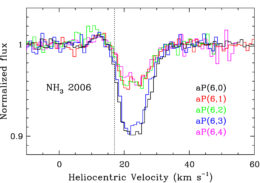How does material move through an accretion disk to the young star at its center? Surprising detections from a fortuitously angled disk have now provided new insights.
Driving Inflow
When stars are born from the collapse of a dense molecular cloud, they spend their early stages surrounded by circumstellar disks: disks of gas and dust that we understand to be accreting onto the young stars at their centers.

Herschel infrared view of the Taurus Molecular Cloud complex, the home of GV Tau. [ESA/Herschel/NASA/JPL-Caltech; acknowledgement: R. Hurt (JPL-Caltech)]
For material to move inwards within a disk, it must first lose angular momentum — but where does that momentum go? What processes remove or redistribute it? In a new study led by Joan Najita (NSF’s NOIRLab), a team of scientists presents high-resolution observations of an unusual disk — one that happens to be angled in such a way as to help us answer these questions.
Lucky Alignment

Schematics representing the likely observing geometry of GV Tau N; the observer is on the right. Top: The line of sight to the disk continuum (orange) passes through the warm molecular atmosphere at larger radii (pink), producing absorption. Bottom: View of the molecular gas velocities. The combination of rotation (blue arrows) and inflow (green arrows) produces net redshifted (red arrows) absorption velocities. [Adapted from Najita et al. 2021]
The unique viewing angle for GV Tau N means that our sightline passes through the disk atmosphere in the inner few au of the disk — the region where planet formation is thought to occur. The molecules in this gas absorb some of the continuum light emitted by the interior disk, leaving signatures in the spectrum that provide valuable insight into the composition and motions of the gas at the surface of the inner disk.
Caught in the Act
Najita and collaborators found evidence for a variety of molecular species in the disk: acetylene (C2H2), hydrogen cyanide (HCN), water (H20), and even ammonia (NH3), which has never before been detected in an inner accretion disk. But the especially interesting result is that these molecules’ absorption lines are redshifted, lying at longer wavelengths than expected if the gas were moving in a stable circular orbit.
This redshift is an indication that the gas observed is flowing rapidly (about 1 au per year) inward along the disk surface — direct evidence for accretion in action. The authors show that their observations match expected mass accretion rates for active T Tauri stars: roughly a few to a few tens of Earth masses per year. The observations fit neatly with a disk accretion model in which angular momentum is redistributed within the disk, causing surface gas to flow in and accrete while the midplane of the disk spreads outward.GV Tau N is a lucky break — its orientation allowed us to make these unique measurements. But it’s surely not alone! With more observations of systems like GV Tau N, we’ll be able to further deepen our understanding of disk accretion.
Citation
“High-resolution Mid-infrared Spectroscopy of GV Tau N: Surface Accretion and Detection of NH3 in a Young Protoplanetary Disk,” Joan R. Najita et al 2021 ApJ 908 171. doi:10.3847/1538-4357/abcfc6



5 Comments
Pingback: Obserwacje akrecji w akcji – PTMA Kraków
Pingback: Obserwacje akrecji w akcji – Astronomia Śląska
Pingback: Supernovae and Galaxies Being Used to Solve Astrophysics’ Biggest Questions | The Daily Space
Pingback: Chance Viewing Angle Reveals Stars Birth | CosmoQuest
Pingback: From NSF’s NOIRLab (National Optical-Infrared Astronomy Research Laboratory) (US) via AAS NOVA : “Accretion in Action in an Angled Disk” | sciencesprings